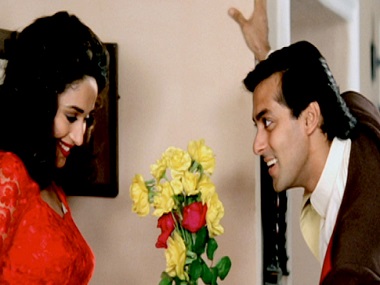Sooraj Barjatya’s 1994 classic Hum Aapke Hain Koun…! released on 5 August, 25 years ago. For the longest time, I evaded watching the movie because of its Bollywood Broadway-style treatment. The film was too happy for me to stomach in the more cynical times of today.
Having finally watched the three-hour film at one go for this piece, I must say it is an achievement unlocked. I was high on doses of unadulterated happiness for the entire day. The little emotional drama, or low point that is conventionally necessary for a conflict, was rather short-lived in Barjatya’s scheme of things. When the ghar ki bhabhi (played by Renuka Shahane) dies, the family decides — even before they can come to terms with her sudden demise — that her bereaved husband (played by Monish Behl) must marry her younger sister (Madhuri Dixit). This, even though Dixit’s character is secretly in love with Behl’s younger brother in the film (Salman Khan). Confusion, much? The premise seems as ridiculous as it is confusing now. However, at that time, Hum Aapke Hain Koun…! was a box office and pop culture rage given the number of bums it put on theatre seats back then. The reason it worked wonderfully well among the audience in 1994 was particularly because the film stood for something and had a strong voice back then. It reestablished the audience’s faith in the traditional Indian value system, at a time when India had opened its gates to liberalisation, and was subsequently facing the threat of losing its grip on the Indian value system.
The youth of the country had an even bigger struggle, especially because the concept of the Indian value system was alien to them. While their parents tried their best to inculcate Indian values among the youth, the latter was busy feeding off the late 1980s and early 1990s films that focused on inter-generational conflicts, in which marriage to the beloved was on the line. Marriage to the beloved, often from an inferior caste or different religion, became the bone of contention. Through films like Aamir Khan and Juhi Chawla-starrer Qayamat Se Qayamat Tak, eloping with the one you choose to love became the order of the day, given the theme of the movies back then. The economic policy of liberalisation served as the final nail in the coffin of the already strenuous relationship between the children and the parents then. While the majority of the generation of parents were employed in family business of their own, their children were no longer bound to follow in their footsteps helplessly. As a result of liberalisation, a number of foreign companies entered the market and gave the children’s generation what they must have been craving for the most at that time — choice. They were empowered by liberalisation as they enjoyed the choice not to inherit their family businesses and instead seek their own calling among the various opportunities easily made available back then.
What films like Hum Aapke Hain Koun…! and Aditya Chopra’s directorial debut Dilwale Dulhania Le Jayenge did back then was to show both the warring generations that romance was possible within the framework of traditional Indian values. Both the films showed how romance blossomed at the peripheries of the traditional big fat Indian family. While the parents’ generation could try to dictate their children’s choice for marriage, these films discouraged it from doing so as that could only lead to confusing, violent conflicts. At the same time, these films served the important role of giving the children agency to choose their partners but not at the cost of upsetting their parents. Love was not looked down upon, but it was strongly emphasised that it should happen only with the approval (read: aashirvad) of their elders. Barjatya introduced sanskari dope with Hum Aapke Hain Koun…! through not only its traditionally rooted outline but also through incessant songs interwoven within the narrative. When I interviewed his uncle Ajit Barjatya for my college magazine, he told me that the decision to incorporate so many songs (over a dozen!) into their narrative was because almost every song represented a traditional Indian ritual, that ranged from stealing the groom’s shoes at the wedding for shagun to the god bharai ritual after pregnancy. No wonder, if there is any film that shaped the elaborate manner in which the big fat Indian wedding is conducted today, it is Hum Aapke Hain Koun…!, with evergreen tracks like ‘Didi Tera Devar Deewana’ and ‘Joote Do Paise Lo’.
But songs substituting lengthy dialogue was not original even then. From the time age old, epics like the Ramayana and the Mahabharata were narrated for the lowest denominator, often illiterate (so books were not an option), through theatre, replete with rhyme and rhythm that every human could comprehend and enjoy. Barjatya only fused this ancient narrative tool with the modern medium of filmmaking to weave a narrative that suited the tastes of both the millennial generation and the one that came before it. Moreover, there was no shade of grey, let alone black, in Hum Aapke Hain Koun…!. In the process, it worked wonders as the ideal escapist film that both generations needed at a time when the country was going through a turmoil at a macro level.


)
)
)
)
)
)
)
)
)



